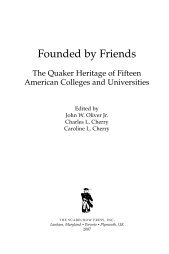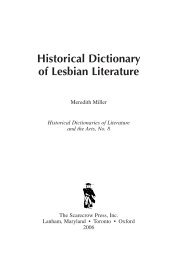Postwar German Cinema and the Horror Film - Scarecrow Press
Postwar German Cinema and the Horror Film - Scarecrow Press
Postwar German Cinema and the Horror Film - Scarecrow Press
Create successful ePaper yourself
Turn your PDF publications into a flip-book with our unique Google optimized e-Paper software.
x Steffen Hantke<br />
film often pinpoint <strong>the</strong> cinema of this period as an inventory of tropes <strong>and</strong> styles<br />
from which horror films have been drawing in all <strong>the</strong>ir national <strong>and</strong> <strong>the</strong>matic<br />
variations. This is <strong>the</strong> heritage of <strong>German</strong> cinema from <strong>the</strong> silent film era—films<br />
associated with <strong>the</strong> glory days of <strong>the</strong> Ufa <strong>and</strong> <strong>the</strong> Decla, with <strong>the</strong> stylistic influence<br />
of Expressionism, <strong>and</strong> with a <strong>the</strong>matic preoccupation with <strong>the</strong> darker aspects<br />
of <strong>the</strong> human psyche, best captured by Lotte Eisner’s almost programmatic<br />
title The Haunted Screen. Equally programmatic is <strong>the</strong> title of S. S. Prawer’s<br />
study of horror cinema, from which this book borrows its own title: Caligari’s<br />
Children: The <strong>Film</strong> as Tale of Terror. 3 <strong>Horror</strong> film, Prawer suggests, emerged<br />
<strong>and</strong> consolidated itself as a genre in <strong>the</strong> wake of a single film, Robert Wiene’s<br />
The Cabinet of Dr. Caligari, with <strong>the</strong> stylistic <strong>and</strong> <strong>the</strong>matic agenda it established.<br />
Prawer’s analysis is too sophisticated to allow such radical reductionism, <strong>and</strong> so<br />
<strong>the</strong> title of his book, I believe, must be taken metonymically, referring to <strong>the</strong><br />
seminal importance of <strong>the</strong> type of film Caligari represents—<strong>German</strong> filmmaking<br />
between <strong>the</strong> two World Wars. Looking back over <strong>the</strong> genealogy of horror<br />
film, we might recognize Caligari as <strong>the</strong> visual <strong>and</strong> <strong>the</strong>matic blueprint for every<br />
claustrophobic nightmare of dehumanization, just as Murnau’s Nosferatu appears<br />
as one, if not <strong>the</strong>, seminal vampire film, The Student of Prague as <strong>the</strong><br />
cinematic key-text about <strong>the</strong> Doppelgänger motif, Lang’s M as <strong>the</strong> first serial<br />
killer film, <strong>and</strong> Lang’s first two Dr. Mabuse films as foundational texts in <strong>the</strong><br />
cinema of individual <strong>and</strong> collective paranoia.<br />
O<strong>the</strong>r critics, concurring with <strong>the</strong> basic conceit in Prawer’s study, confirm<br />
<strong>the</strong> idea that <strong>German</strong> cinema during <strong>the</strong> Weimar years was, in fact, fertile<br />
grounds for <strong>the</strong> horror film. Summarizing <strong>the</strong> state of current research on <strong>the</strong><br />
topic, Peter Hutchings makes <strong>the</strong> connection between horror film <strong>and</strong> <strong>the</strong> <strong>German</strong><br />
films of <strong>the</strong> period explicit: “most accounts of horror history published in<br />
<strong>the</strong> past thirty years refer to <strong>the</strong> <strong>German</strong> productions The Cabinet of Dr. Caligari<br />
(1919) <strong>and</strong> Nosferatu (1922) as horror films” (3). To <strong>the</strong>se two seminal films<br />
Hutchings also adds The Student of Prague (1913) <strong>and</strong> The Golem (1913), asserting<br />
that, taken toge<strong>the</strong>r, <strong>the</strong>se films “might well anticipate <strong>and</strong> be an influence<br />
upon later horror production” (9). David Skal, in The Monster Show: A<br />
Cultural History of <strong>Horror</strong>, picks up this <strong>the</strong>me of influence in his own discussion<br />
of cinematic history. Discussing <strong>German</strong> films of <strong>the</strong> Weimar years in <strong>the</strong><br />
context of such modernist movements as Surrealism <strong>and</strong> phenomena like <strong>the</strong><br />
French Gr<strong>and</strong> Guignol, Skal ends <strong>the</strong> chapter entitled “‘You Will Become Caligari’:<br />
Monsters, Mountebanks <strong>and</strong> Modernism” with this tongue-in-cheek evocation<br />
of <strong>the</strong> influence <strong>German</strong> expressionist films were to have, especially on<br />
<strong>the</strong> American horror film:<br />
Whe<strong>the</strong>r Americans liked it or not, an enormous westward expansion of<br />
horrors was taking shape, a manifest destiny of <strong>the</strong> macabre. The dark beings<br />
that had used <strong>the</strong> European avant-garde to find a modern expression<br />
would soon begin crossing <strong>the</strong> Atlantic, in film canisters instead of coffins,<br />
waiting to be animated in darkened rooms through <strong>the</strong> application of artificial<br />
light. […] Shaken out of <strong>the</strong>ir ancient crypts <strong>and</strong> castles by <strong>the</strong> mod-
















